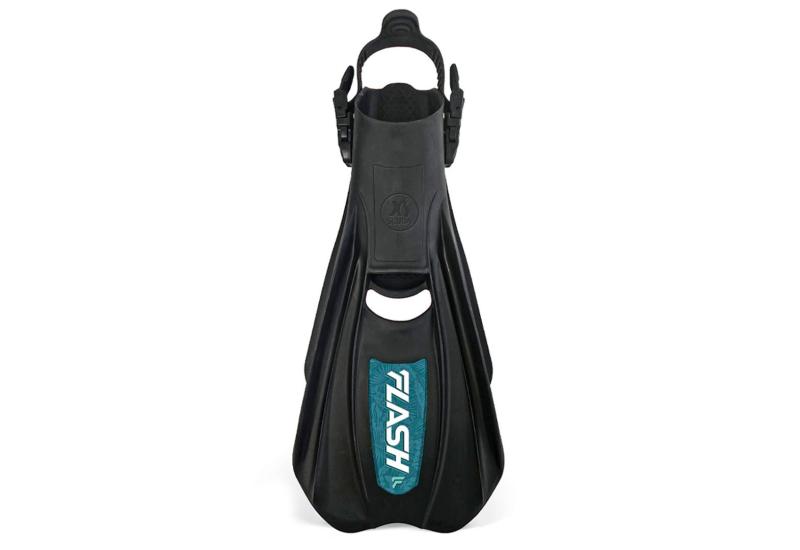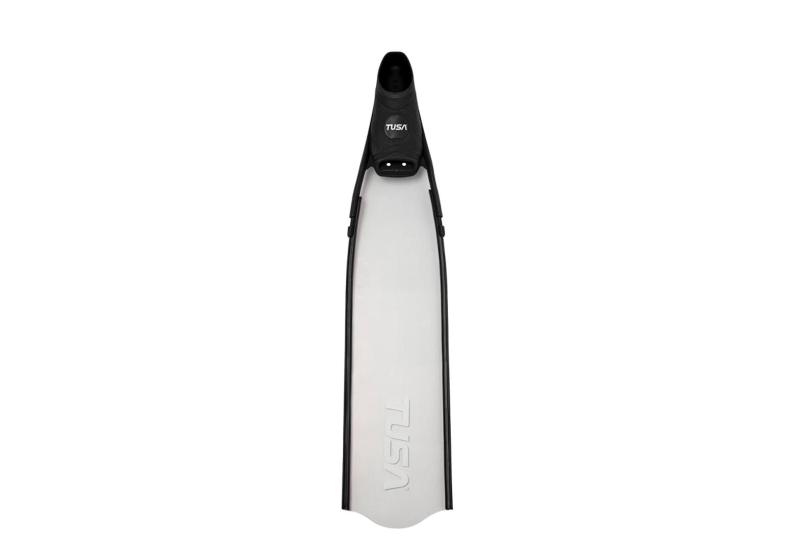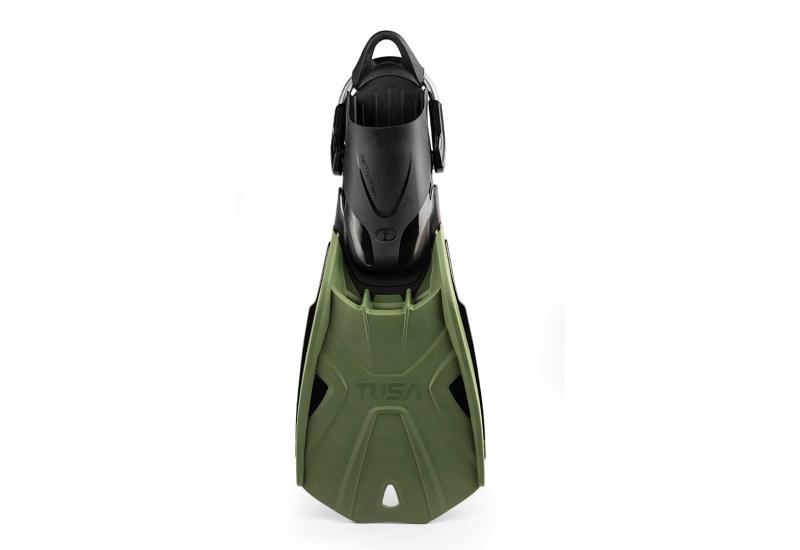2005 Fin Test: Protocols
Objective Performance Measures
Speed: Six test divers, using both a standard flutter kick and a frog kick, at an average depth of 15 feet, take each fin on three speed runs for the flutter kick and two runs for the frog kick using specially designed underwater digital speedometers. The highest speed for each fin is taken from each diver, then averaged, to come up with average speeds for each fin. Click here to watch the test video.
Thrust: Six test divers, using the flutter kick, at an average depth of 10 feet, grab onto a rigid-handled harness that is connected to a scale that is anchored to a pier piling. Holding the handle securely against their bodies, test divers slowly kicked forward, taking the slack out of the harness. Once at the end of the tether, test divers began to kick, slowly at first, then increasing speed to reach their maximum thrust, at which time the test supervisor, on station at the scale, records the reading. Test divers then ease off, rest, and repeat the process. Three readings are taken by each diver for each fin, which are averaged. Click here to watch the test video.
Maneuverability: Six test divers, using a flutter kick, swim an obstacle course that includes a series of tight, 60-degree turns in approximately 10 feet of water. While on the course divers' hands clutch either weight belts or BC straps to ensure all maneuvering power is generated by the fins. Divers swim two round-trip circuits per fin, timing themselves using digital stopwatches. The fastest time for each fin is taken from each diver, then averaged, to come up with a maneuverability course time. Click here to watch the test video.
Efficiency: Six test divers, using a flutter kick in approximately 10 feet of water, swim a straight-line course 65 feet long, including a 15- foot "runway" to allow them to get up to their most efficient kicking rhythm--a kick they would be able to maintain for a period of time without overstressing their leg muscles. Timing themselves with digital stopwatches, the divers complete two runs for each fin. The best runs for each diver for each fin were then averaged. Click here to watch the test video.
Ergonomic Tests
Using a 1 to 5 scale (5=excellent, 4=very good, 3=good, 2=fair, 1=poor) test divers evaluate each fin in 10 ergonomic points divided into three categories: "Most Important," "Moderately Important," and "Convenience Elements." They also provide written comments, which are included in the review.
Most Important
1) Power vs. Stress. The perception of power produced vs. effort required.
2) Stability. How much the fins wobble, slice from side to side, or hit each other during the kick cycle.
3) Maneuverability. The ease of turning, as well as getting in and out of tight places using fin power; i.e. backing up, changing or reversing directions, using small fin movements.
4) Acceleration. During an underwater swim, the ability to quickly pick up speed.
Moderately Important
5) Fit and Comfort. In and out of the water.
6) Alternate Kicks. Ease and effectiveness of frog, dolphin and sculling kicks.
7) Surface swim. Both face-down and while on the back.
Convenience Elements
8) Donning and Doffing. Prior to dive, after the dive, wile on deck.
9) Adjusting for Fit. Ease of using buckles and straps, both in and out of the water.
10) Non-Skid. The sense of security on a wet boat deck geared up while wearing fins.
How We Score the Results.
The total scores are based on the adjusted scores for ergonomic performance (actual scores x 3 for "Most Important" categories, actual scores x 2 for "Moderately Important" categories, and actual scores x 1 for "Convenience Elements"), plus numerical scores from the speed, thrust, efficiency and slalom course runs.
Objective Performance Measures
Speed: Six test divers, using both a standard flutter kick and a frog kick, at an average depth of 15 feet, take each fin on three speed runs for the flutter kick and two runs for the frog kick using specially designed underwater digital speedometers. The highest speed for each fin is taken from each diver, then averaged, to come up with average speeds for each fin. Click here to watch the test video.
Thrust: Six test divers, using the flutter kick, at an average depth of 10 feet, grab onto a rigid-handled harness that is connected to a scale that is anchored to a pier piling. Holding the handle securely against their bodies, test divers slowly kicked forward, taking the slack out of the harness. Once at the end of the tether, test divers began to kick, slowly at first, then increasing speed to reach their maximum thrust, at which time the test supervisor, on station at the scale, records the reading. Test divers then ease off, rest, and repeat the process. Three readings are taken by each diver for each fin, which are averaged. Click here to watch the test video.
Maneuverability: Six test divers, using a flutter kick, swim an obstacle course that includes a series of tight, 60-degree turns in approximately 10 feet of water. While on the course divers' hands clutch either weight belts or BC straps to ensure all maneuvering power is generated by the fins. Divers swim two round-trip circuits per fin, timing themselves using digital stopwatches. The fastest time for each fin is taken from each diver, then averaged, to come up with a maneuverability course time. Click here to watch the test video.
Efficiency: Six test divers, using a flutter kick in approximately 10 feet of water, swim a straight-line course 65 feet long, including a 15- foot "runway" to allow them to get up to their most efficient kicking rhythm--a kick they would be able to maintain for a period of time without overstressing their leg muscles. Timing themselves with digital stopwatches, the divers complete two runs for each fin. The best runs for each diver for each fin were then averaged. Click here to watch the test video.
Ergonomic Tests
Using a 1 to 5 scale (5=excellent, 4=very good, 3=good, 2=fair, 1=poor) test divers evaluate each fin in 10 ergonomic points divided into three categories: "Most Important," "Moderately Important," and "Convenience Elements." They also provide written comments, which are included in the review.
Most Important
1) Power vs. Stress. The perception of power produced vs. effort required.
2) Stability. How much the fins wobble, slice from side to side, or hit each other during the kick cycle.
3) Maneuverability. The ease of turning, as well as getting in and out of tight places using fin power; i.e. backing up, changing or reversing directions, using small fin movements.
4) Acceleration. During an underwater swim, the ability to quickly pick up speed.
Moderately Important
5) Fit and Comfort. In and out of the water.
6) Alternate Kicks. Ease and effectiveness of frog, dolphin and sculling kicks.
7) Surface swim. Both face-down and while on the back.
Convenience Elements
8) Donning and Doffing. Prior to dive, after the dive, wile on deck.
9) Adjusting for Fit. Ease of using buckles and straps, both in and out of the water.
10) Non-Skid. The sense of security on a wet boat deck geared up while wearing fins.
How We Score the Results.
The total scores are based on the adjusted scores for ergonomic performance (actual scores x 3 for "Most Important" categories, actual scores x 2 for "Moderately Important" categories, and actual scores x 1 for "Convenience Elements"), plus numerical scores from the speed, thrust, efficiency and slalom course runs.









